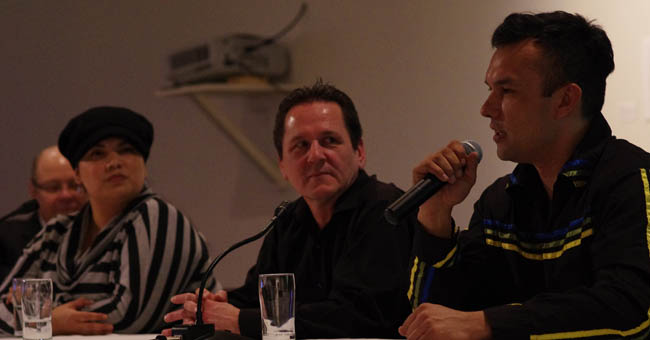Will Indigenous cultures assimilate everyone else?

By Rick Garrick
THUNDER BAY – Decolonization, art and future generations were on the agenda at the Thunder Bay Art Gallery’s “Let’s Keep Talking” panel discussion.
“On the theme of decolonization, we should always be thinking about what are we doing to make the next generation more Anishinabek than we are,” says Lake Helen First Nation artist Shawn Hedican during the Feb. 19 gathering. “That’s what I often think about when I’m teaching my baby different things, even just when I bring her outside to watch me do different things in the yard.”
Hedican wants to learn more about Anishinaabemowin so he can share the language with others and “undo everything that was done to my family to pretty much obliterate our culture in one generation.”
Hedican sees a future of scarce resources, which will bring people together.
“There won’t be the resources to oppress Indigenous populations all over the world,” Hedican says. “Various groups and cultures, if left to their own devices, will probably assimilate to our culture.”
Hedican, Couchiching FN writer Jane-Rae Yerxa and Inuit artist Barry Pottle spoke about their relationships with Indigenous art and decolonization during the panel discussion, which was moderated by Mohawk researcher John Akweniiostha Hodson.
Yerxa says the current way of life on earth is unsustainable.
“As a human race, that’s going to push us to come together so we can all live with the rest of creation,” Yerxa says. “I would really like to see a time where talking about this is just so blasé because we’ve actually done the work to move beyond that, where those conversations aren’t filled with tension. Where, when I’m going to come here, I don’t need to worry who’s going to beat me up because of what I’m saying or how I’m going to be interpreted or misunderstood.”
Pottle, whose work was on display in the art gallery’s “Decolonize Me” exhibition, brought up a recent example of colonization at the Toronto Zoo.
“They got a polar bear, Nanuk, a little baby, and they put out a contest for a name for that bear,” Pottle says. “Somebody put in the word Searik, which they thought was Inuktitut for beautiful. And it’s not.”
Pottle says his community leaders discovered the word was taken from WikiAnswers.
“C’mon now, this is the 21st century,” Pottle says. “The response from a very good Elder friend of mine, Piita Irniq, was ‘next time they should consult Inuit as opposed to the Internet.’”
Pottle says it is important to let people know what is right and what is not right.
The “Decolonize Me” exhibition featured six contemporary Aboriginal artists whose work challenges, interrogates and reveals Canada’s long history of colonization in daring and innovative ways.


